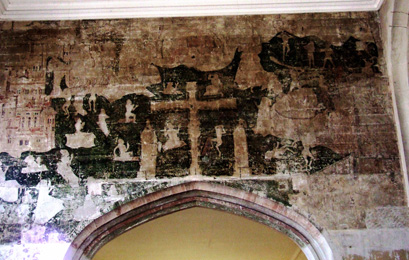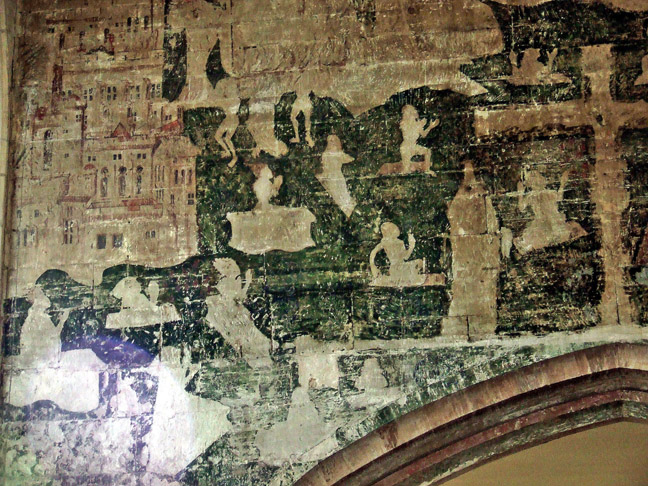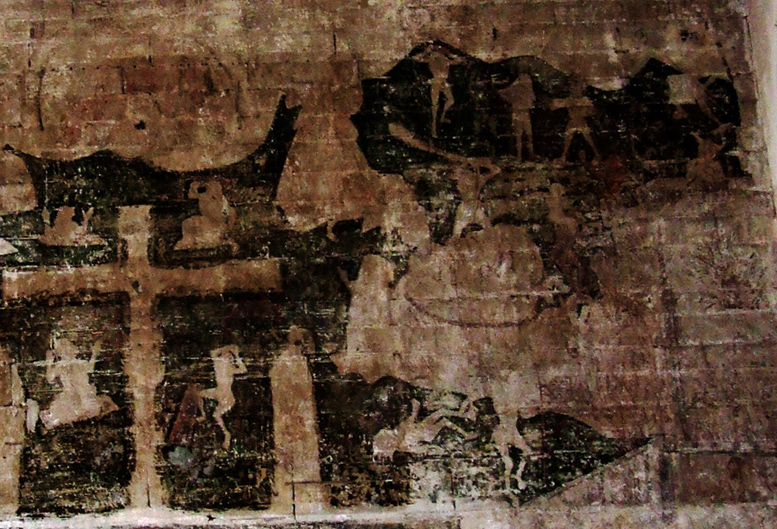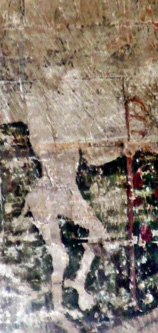Guild Chapel, Stratford-on-Avon (†Coventry) C.15
Doom

The small image at the top right will show you the Doom in its entirety; the first of several forthcoming detailed photographs is below at the left. Getting an idea of scale here can be difficult; the chapel of the Guild of the Holy Cross is a sizeable building, and the Doom stretches across the width of the arch from one side wall to the other, as should be visible even in the small picture. At the top it meets the ceiling, which has been lowered at some post-medieval date (various restorations were carried out in the 19th century) and was probably originally vaulted. The standard elements of the medieval Doom are all here, including the outline marking the position of the great Rood above the arch, and some far less commonly found ones as well, such as the hugely detailed multi-story building or buildings representing the apartments of Heaven – there are evidently ‘many mansions’ in this depiction of the Holy City.

The photograph at the left shows the left-hand side of the Doom, with, to the right beyond the buildings, what looks like a curtained entrance, A figure within is probably a very unclear St Peter, and at least two risen souls are making their way, apparently confidently, towards it. Below these at least one pope with a reddish tiara is still rising from his tomb, and there are others in papal or episcopal headgear sitting up in their tombs further below. All are in attitudes of prayerful amazement. Further right, towards the centre, is the matrix of a Rood figure of the Virgin Mary, with the matrix of the Rood itself further right still. Above and below the outline of the transverse bar of the Cross, more figures rise, hands raised in wonder.
On the other side of the Cross-outline the scenes of Hell and the damned are less crowded and more coherent than they are in many similar paintings – this was made by a painter who understood that less can be more. To the right of the rainbow arch on which the judging Christ once sat (or possibly rested his feet on while sitting on a larger-scale rainbow now gone with the lowering of the ceiling) are the faint and faded remains of a figure who may be John the Evangelist or possibly the Virgin Mary in intercession – their relative positions are not immutable.

Further right again is perhaps the most interesting detail of all – three small figures standing (apparently) in mid-air on a very dark background below an undulating outline of clouds. The leftmost figure of this trio seems on the point of disappearing into the cloud above, the central one stands apparently motionless, and the figure on the right holds something rectangular at chest level. This may have been an identifying inscription, but anything approaching certainty is impossible now. Speculation is permissible, though, and my own candidates for these three people would be Enoch, Elijah (much as at Chaldon centuries earlier) with the Saved Thief holding the transverse bar of his Cross completing the trio at the right. At the farthest right an upside-down figure, showing devilish hooves instead of feet, vanishes into the reddish-black murk below. An overthrown Antichrist is one obvious possibility, but there are others.

Below these three figures is a group of unfortunates bound in a red (apparently burning) chain visible in the photograph. A devil stands behind, arm raised, probably to thrash any potential escapees into submission. Despite this, one individual lies supine beside the chained group on the near side. The chained group is being driven towards a Mouth of Hell, conventionally painted at the right and well-nigh impossible to see now. Below this is an upright devil, possibly Satan himself. Few details of his figure are clear, but his hooved feet can be seen, and so can the three-pronged flesh-hook that evidently serves as a staff of office. He is close to a wall; the intention may have been to show him patrolling the boundaries of his kingdom. This is very much a medieval detail, reflecting medieval thinking. It would be more than a century before Christopher Marlowe put his penetrating psychological insight that ‘Hell hath no limits, nor is circumscribed…’¹ into the mouth of his Mephostophilis. Here and now, in about 1490, it seems, Hell has its frontiers.
There are other figures, and groups of figures, in the painting, but none is clear enough to photograph and reproduce usefully online. In fact, it looks as though this Doom was painted directly onto the stonework, or at best onto the thinnest skim of plaster, much of which has now gone, leaving only the imprint on the stonework. This happened elsewhere – at Claverley in Shropshire, for example, but it is a pity that it happened to a painting that Shakespeare would undoubtedly have known.
Address and telephone for the Guild Chapel:
Chapel Lane, Stratford-upon-Avon CV37 6EP, England
Tel: 44-1789-293127
¹ Christopher Marlowe, Dr Faustus, Act 11, Scene 2, l.120, Oxford, ed. R. Gill, 1971